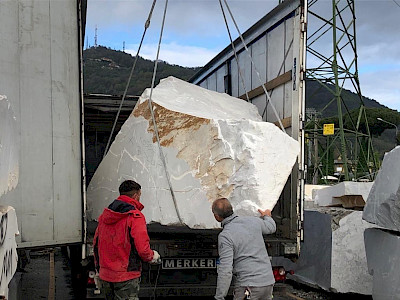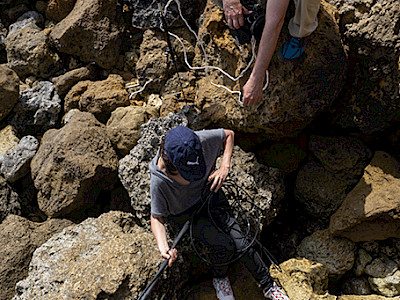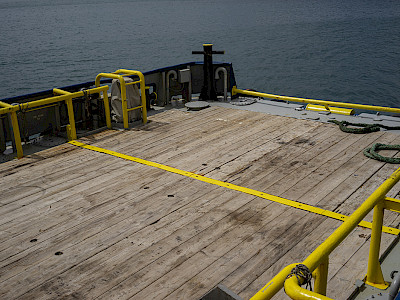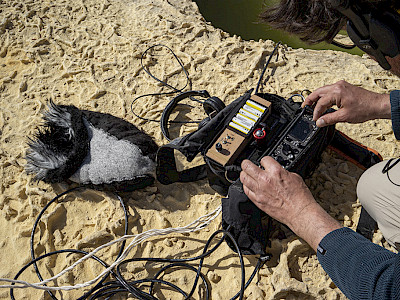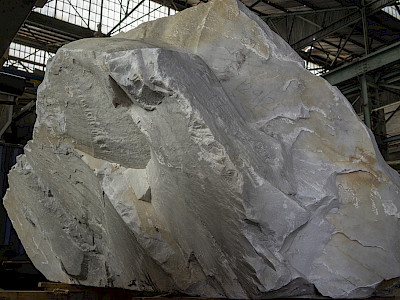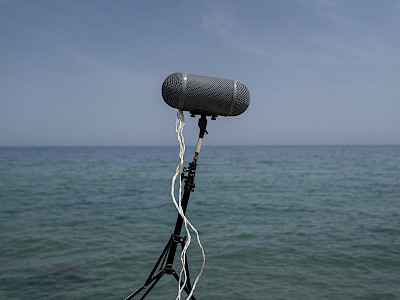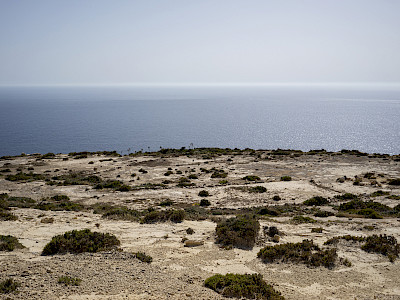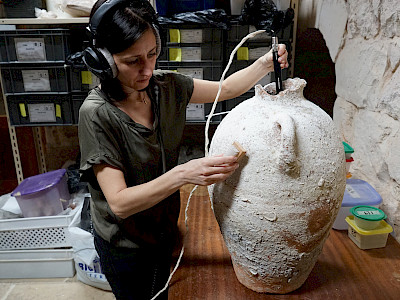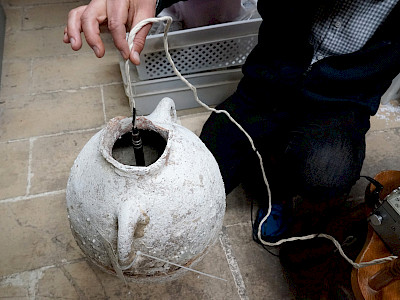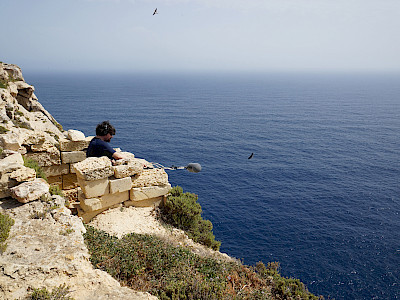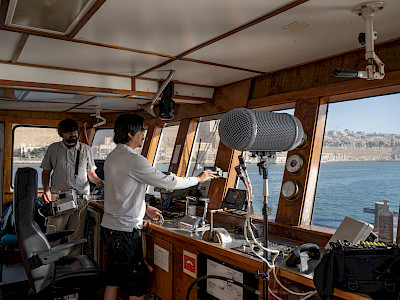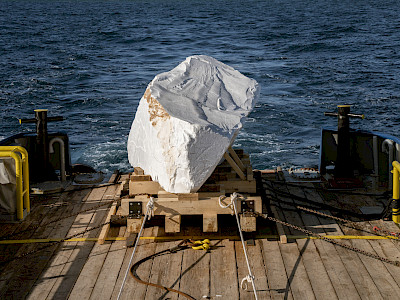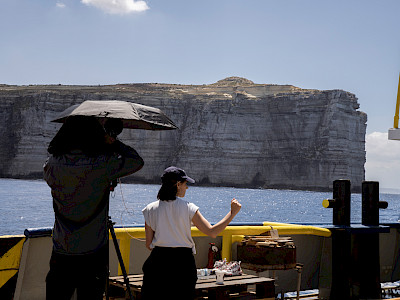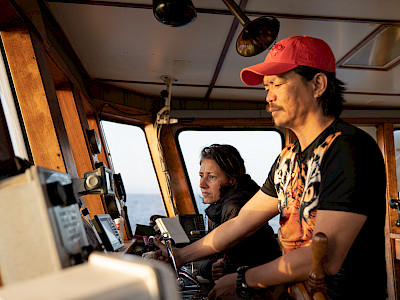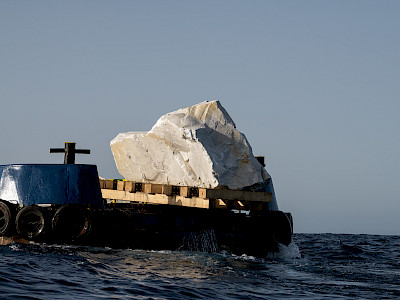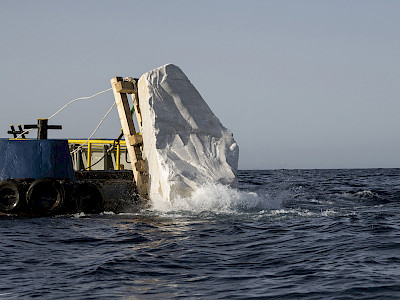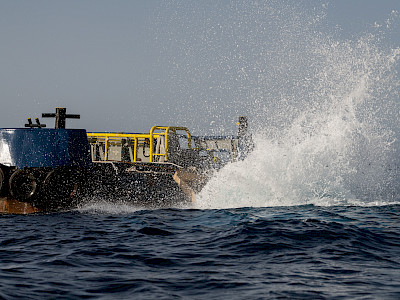02.06.2021
The Journey is a performance of a ship navigating a GPS content-related route inspired by time, history and current geopolitical data researched together with different experts and communities in an area of the Mediterranean Sea between Italy, Malta, Tunisia, Libya. The narrative is centered on the decision and consequences of dropping a 20-ton marble block awarded to the artist by the iconic Michelangelo quarry in Carrara, Italy, yet left untouched. In fact, Rossella Biscotti uses the block as a mechanism to unpack the political, economic and environmental layers of a complex body of water. The point of departure is the island of Malta, a country located in between Europe and Africa, and a collection of maps showing different information comprising data on shipwrecks, cabling, military checks, licenses for energy and oil companies in the deadliest migration route of the Mediterranean Sea. This artistic gesture will take place between the 8th and the 30th of May, depending on the weather conditions, and in collaboration with the ship's crew, a poet and a composer. Thus, it will be the only invisible performance at the festival, echoing the hidden nature of what is going on in the Mediterranean Sea. The Journey will become a layered sound composition, that will be presented in 2022, exposing the politics of visibility and invisibility, off-shore exploration and exploitation.
The Journey
In 2010 I was awarded a 20-ton block of marble from the Michelangelo quarry in Carrara (Italy). Exactly one year ago, this rock was extracted, transported to the coast and loaded onto a boat. The boat then set sail for three days on a symbolic route between Italy, Malta, Tunisia and Libya and finally at a set point releasing the 20 ton marble block into the Mediterranean Sea. The route carefully plotted and followed on GPS, was designed to highlight and identify points of interest in the Mediterranean – a 1710 meter deep geological rift, several arbitrary nautical borders demarcating oil and gas concessions, areas of military operations, or even the migration path of a sea-turtle as it crosses the patrolling lines of the European Border Agency FRONTEX. This performance, invisible to a general public, was my contribution to last year’s edition of Kunstenfestivaldesarts.
While sailing, I began to think of the ship as an ear, capable of capturing reality both above and under the salty sea, catching sound frequencies, extending their acoustic range all the way to the Tunisian or Libyan coasts, traversing time and connecting different areas and points through sound waves. The sound recorded on this journey beginning with the extraction of the marble, then along the shores of Malta and Tunisia finally leading to a location in the middle of the sea, is the starting point of the immersive eight channel sonic composition presented here. It includes the hum of engines; the ceaseless sea churn; the songs of seafarers and fishermen; the unique rhythmic matrix and resonances from ancient amphorae. We re-recorded the historical boat distress drum beats on a percussion instrument and edited them to accompany the words of Chamseddine Marzoug as he describes the bodies he found in the water or swept on the shore. We had recorded Marzoug in a bleak desert landscape, a landfill where he had buried all the bodies he found, in the background the sound of a banging fence by fortuitous accident shares the same frequencies of the percussive distress patterns we had recorded- both signals become indistinguishable.
The Journey is an elaboration of this dimension of listening, recording and composing.
Every night live guests enter a metaphorical black box, adding their reflections, poetry, or artistic interventions. They offer encounters that shift the immersive soundscape into an intimate dimension; one voice, one reel, and a subjective research into the politics of visibility and invisibility.
Rossella Biscotti, April 2022
Sinthujan Varatharajah
Water reflects the sky above its surface. It however also gives testimony to the lands neighbouring it; to the atrocities taking place upon it; to the violence that doesn’t end where land drowns. Water is where human violence learns flowing, sailing, swimming and drowning; littering water bodies with human waste. Connecting different histories of human movements on water and human movements of water, Sinthujan Varatharajah explores how water bodies across our world bear witness to human violence.
Attila Faravelli
Since few years Attila Faravelli is interested in capturing mono field recordings with a Nagra III reel to reel recorder. The lack of spatial information provided by mono reveals the act of recording as a series of positioned and relative choices. In his performance for The Journey, some of the material that was collected for the installation is played in their original isolated form, the way they were collected, before being arranged in a counterpoint of many sounds.
Joëlle Sambi
Perhaps some bodies are the cogs in a great machine. Perhaps it’s the macabre factory of fragmented humanity. Perhaps you have to die with your skin puffed up by the salt of the sea to be granted a certain humanity. Perhaps… maybe the questions aren’t enough. Perhaps we won’t stop asking them. Putting them there. With or without a bang. As ostentatious as an orange dinghy lost on a broken radar. Joëlle Sambi is a poet, author and performer and together with sound designer Nicolas Pommier she offers a sonic slam that questions our humanity which withers to the rhythm of the inhuman migration policy of Europe.
Juan Pablo Pacheco Bejarano
The ability to sense each other and the world at a distance is what, today, we could call telepathy, an experience that the internet has rendered increasingly palpable for the modern human. But, is digital technology the only form of telepathy there is? What other networks, human and non-human, sustain the sensing web of the world? Through the performative lecture when technology becomes a ruin on the ocean floor, Juan Pablo Pacheco Bejarano will propose a set of speculative associations between the internet, colonialism, minerals and water, seeking to expand on the entangled role that the ocean plays in the history of infrastructural networks.
Sound design by Juan Pablo Pacheco Bejarano and Rodrigo Pacheco Bejarano
Presentation: Kunstenfestivaldesarts
On the Diligence ship: Artist: Rossella Biscotti | Field recordist: Attila Faravelli | DOP: Cristian Manzutto | Photographer: Alexandra Pace | Blitz's Curator: Sara Dolfi Agostini | Master Mariners: Ramon Espiritosantu, Vladimir Daniel Dalit and their wonderful crew | GIS maps: Catalogtree I Project manager: Kristina Borg | Research in Tunisia: Emna Lakhoua | Project developed with: Blitz Valletta | 8th edition of Dream City Festival Tunis within the framework of the project Between Land and Sea | In collaboration with: Timmy Gambin (Associate Professor of Maritime Archaeology, University of Malta), Anthony Gruppetta (veterinary surgeon), Aaron Micallef (Associate Professor of Geosciences, University of Malta), Alarmphone, Lewis Baldacchino (Operations Manager, Port Logistics Operations Ltd), Elman Srl (Pomezia), Studi d’Arte Cave Michelangelo Carrara, the fishermen community of El Haouaria, Kerkennah Islands and the Gulf of Gabes | Supported by Mondriaan Fonds

